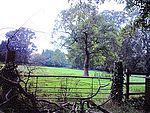Black Dog railway station
Disused railway stations in CheshireFormer London and North Western Railway stationsPages with no open date in Infobox stationRailway stations in Great Britain closed in 1898Railway stations in Great Britain opened in 1840 ... and 1 more
Use British English from April 2017

Black Dog railway station was the first station that served the village of Waverton in Cheshire West and Chester, England. The stop, which was open from 1840 to 1898, was as "Black Dog" after a nearby public house, but it was sometimes referred to as "Waverton". The station was closed in 1898 after it was replaced with the second station at Waverton, which was about 120 m (390 ft) west of Black Dog; it closed to passengers in 1959.
Excerpt from the Wikipedia article Black Dog railway station (License: CC BY-SA 3.0, Authors, Images).Black Dog railway station
Whitchurch Road,
Geographical coordinates (GPS) Address Nearby Places Show on map
Geographical coordinates (GPS)
| Latitude | Longitude |
|---|---|
| N 53.1625 ° | E -2.8164 ° |
Address
Whitchurch Road
Whitchurch Road
CH3 9AT , Waverton
England, United Kingdom
Open on Google Maps









